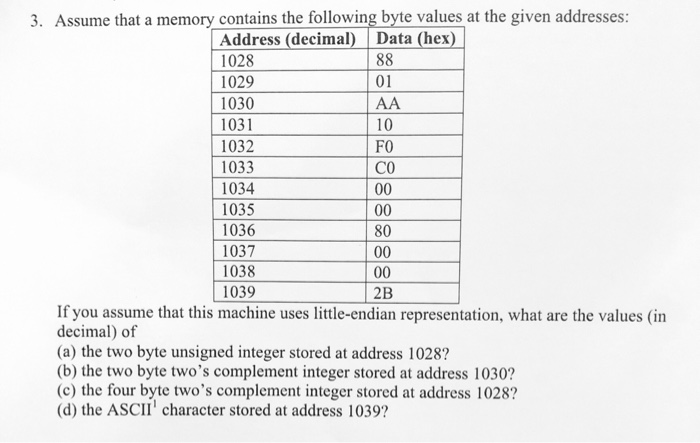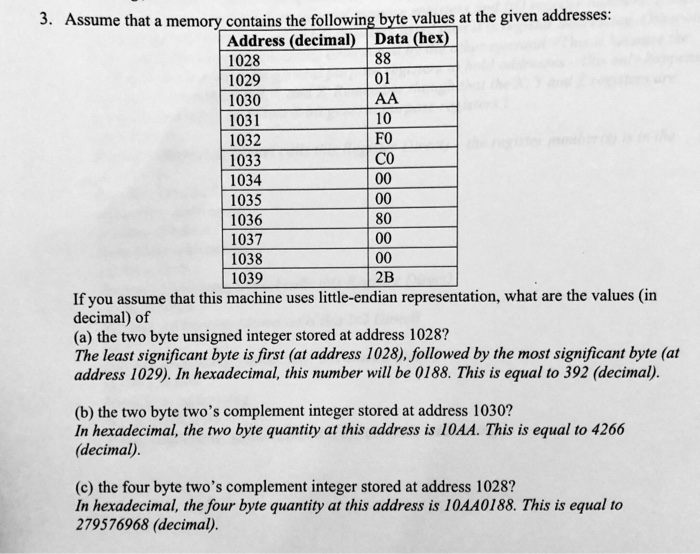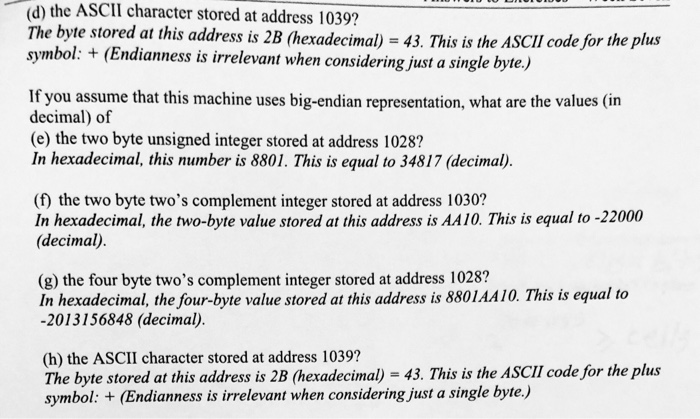[Solved]3 Assume Memory Contains Following Byte Values Given Addresses Address Decimal Data Hex 10 Q37199557

Please show working out to get the answer below


 3. Assume that a memory contains the following byte values at the given addresses Address (decimal) Data (hex) 1028 1029 1030 1031 1032 1033 1034 1035 1036 1037 1038 1039 01 10 F0 CO 80 2B If you assume that this machine uses little-endian representation, what are the values (in decimal) of (a) the two byte unsigned integer stored at address 1028? (b) the two byte two’s complement integer stored at address 1030? (c) the four byte two’s complement integer stored at address 1028? (d) the ASCII’ character stored at address 1039? 3. Assume that a memory contains the following byte values at the given addresses: Address (decimal) Data (hex) 1028 1029 1030 1031 1032 1033 1034 1035 1036 1037 1038 1039 01 10 FO CO 80 2B If you assume that this machine uses little-endian representation, what are the values (in decimal) of (a) the two byte unsigned integer stored at address 1028? The least significant byte is first (at address 1028), followed by the most significant byte (at address 1029). In hexadecimal, this number will be 0188. This is equal to 392 (decimal). (b) the two byte two’s complement integer stored at address 1030? In hexadecimal, the two byte quantity at this address is 10AA. This is equal to 4266 (decimal) (c) the four byte two’s complement integer stored at address 1028? In hexadecimal, the four byte quantity at this address is 10AA0188. This is equal to 279576968 (decimal). (d) the ASCII character stored at address 1039? The byte stored at this address is 2B (hexadecimal) – 43. This is the ASCII code for the plus symbol: + (Endianness is irrelevant when considering just a single byte.j If you assume that this machine uses big-endian representation, what are the values (in decimal) of (e) the two byte unsigned integer stored at address 1028? In hexadecimal, this number is 8801. This is equal to 34817 (decimal). (f) the two byte two’s complement integer stored at address 1030? In hexadecimal, the two-byte value stored at this address is AA10. This is equal to -22000 (decimal) (g) the four byte two’s complement integer stored at address 1028? In hexadecimal, the four-byte value stored at this address is 8801AA10. This is equal to -2013156848 (decimal). (h) the ASCII character stored at address 1039? The byte stored at this address is 2B (hexadecimal) – 43. This is the ASCIl code for the plus symbol: (Endianness is irrelevant when considering just a single byte.) If you assume that this machine uses big-endian representation, what are the values (in decimal) of (e) the two byte unsigned integer stored at address 1028? (f) the two byte two’s complement integer stored at address 1030? (g) the four byte two’s complement integer stored at address 1028? (h) the ASCII character stored at address 1039? Show transcribed image text 3. Assume that a memory contains the following byte values at the given addresses Address (decimal) Data (hex) 1028 1029 1030 1031 1032 1033 1034 1035 1036 1037 1038 1039 01 10 F0 CO 80 2B If you assume that this machine uses little-endian representation, what are the values (in decimal) of (a) the two byte unsigned integer stored at address 1028? (b) the two byte two’s complement integer stored at address 1030? (c) the four byte two’s complement integer stored at address 1028? (d) the ASCII’ character stored at address 1039?
3. Assume that a memory contains the following byte values at the given addresses Address (decimal) Data (hex) 1028 1029 1030 1031 1032 1033 1034 1035 1036 1037 1038 1039 01 10 F0 CO 80 2B If you assume that this machine uses little-endian representation, what are the values (in decimal) of (a) the two byte unsigned integer stored at address 1028? (b) the two byte two’s complement integer stored at address 1030? (c) the four byte two’s complement integer stored at address 1028? (d) the ASCII’ character stored at address 1039? 3. Assume that a memory contains the following byte values at the given addresses: Address (decimal) Data (hex) 1028 1029 1030 1031 1032 1033 1034 1035 1036 1037 1038 1039 01 10 FO CO 80 2B If you assume that this machine uses little-endian representation, what are the values (in decimal) of (a) the two byte unsigned integer stored at address 1028? The least significant byte is first (at address 1028), followed by the most significant byte (at address 1029). In hexadecimal, this number will be 0188. This is equal to 392 (decimal). (b) the two byte two’s complement integer stored at address 1030? In hexadecimal, the two byte quantity at this address is 10AA. This is equal to 4266 (decimal) (c) the four byte two’s complement integer stored at address 1028? In hexadecimal, the four byte quantity at this address is 10AA0188. This is equal to 279576968 (decimal). (d) the ASCII character stored at address 1039? The byte stored at this address is 2B (hexadecimal) – 43. This is the ASCII code for the plus symbol: + (Endianness is irrelevant when considering just a single byte.j If you assume that this machine uses big-endian representation, what are the values (in decimal) of (e) the two byte unsigned integer stored at address 1028? In hexadecimal, this number is 8801. This is equal to 34817 (decimal). (f) the two byte two’s complement integer stored at address 1030? In hexadecimal, the two-byte value stored at this address is AA10. This is equal to -22000 (decimal) (g) the four byte two’s complement integer stored at address 1028? In hexadecimal, the four-byte value stored at this address is 8801AA10. This is equal to -2013156848 (decimal). (h) the ASCII character stored at address 1039? The byte stored at this address is 2B (hexadecimal) – 43. This is the ASCIl code for the plus symbol: (Endianness is irrelevant when considering just a single byte.) If you assume that this machine uses big-endian representation, what are the values (in decimal) of (e) the two byte unsigned integer stored at address 1028? (f) the two byte two’s complement integer stored at address 1030? (g) the four byte two’s complement integer stored at address 1028? (h) the ASCII character stored at address 1039? Show transcribed image text 3. Assume that a memory contains the following byte values at the given addresses Address (decimal) Data (hex) 1028 1029 1030 1031 1032 1033 1034 1035 1036 1037 1038 1039 01 10 F0 CO 80 2B If you assume that this machine uses little-endian representation, what are the values (in decimal) of (a) the two byte unsigned integer stored at address 1028? (b) the two byte two’s complement integer stored at address 1030? (c) the four byte two’s complement integer stored at address 1028? (d) the ASCII’ character stored at address 1039?
3. Assume that a memory contains the following byte values at the given addresses: Address (decimal) Data (hex) 1028 1029 1030 1031 1032 1033 1034 1035 1036 1037 1038 1039 01 10 FO CO 80 2B If you assume that this machine uses little-endian representation, what are the values (in decimal) of (a) the two byte unsigned integer stored at address 1028? The least significant byte is first (at address 1028), followed by the most significant byte (at address 1029). In hexadecimal, this number will be 0188. This is equal to 392 (decimal). (b) the two byte two’s complement integer stored at address 1030? In hexadecimal, the two byte quantity at this address is 10AA. This is equal to 4266 (decimal) (c) the four byte two’s complement integer stored at address 1028? In hexadecimal, the four byte quantity at this address is 10AA0188. This is equal to 279576968 (decimal).
(d) the ASCII character stored at address 1039? The byte stored at this address is 2B (hexadecimal) – 43. This is the ASCII code for the plus symbol: + (Endianness is irrelevant when considering just a single byte.j If you assume that this machine uses big-endian representation, what are the values (in decimal) of (e) the two byte unsigned integer stored at address 1028? In hexadecimal, this number is 8801. This is equal to 34817 (decimal). (f) the two byte two’s complement integer stored at address 1030? In hexadecimal, the two-byte value stored at this address is AA10. This is equal to -22000 (decimal) (g) the four byte two’s complement integer stored at address 1028? In hexadecimal, the four-byte value stored at this address is 8801AA10. This is equal to -2013156848 (decimal). (h) the ASCII character stored at address 1039? The byte stored at this address is 2B (hexadecimal) – 43. This is the ASCIl code for the plus symbol: (Endianness is irrelevant when considering just a single byte.)
If you assume that this machine uses big-endian representation, what are the values (in decimal) of (e) the two byte unsigned integer stored at address 1028? (f) the two byte two’s complement integer stored at address 1030? (g) the four byte two’s complement integer stored at address 1028? (h) the ASCII character stored at address 1039?
Expert Answer
Answer to 3. Assume that a memory contains the following byte values at the given addresses Address (decimal) Data (hex) 1028 1029… . . .
OR

